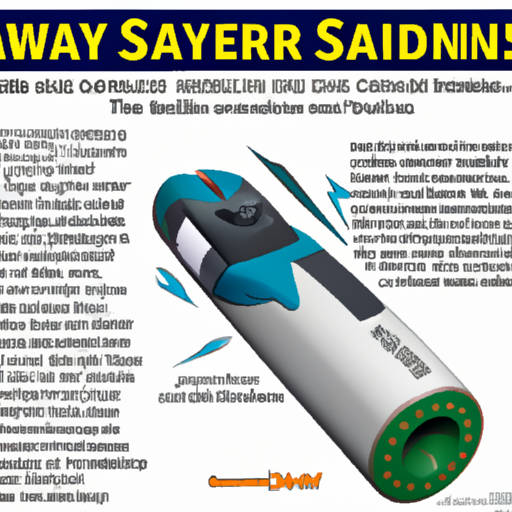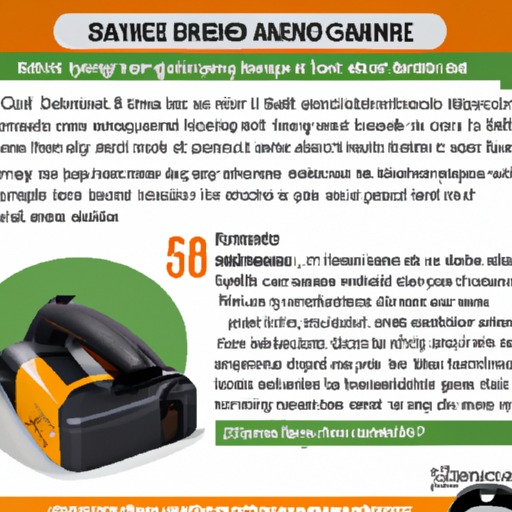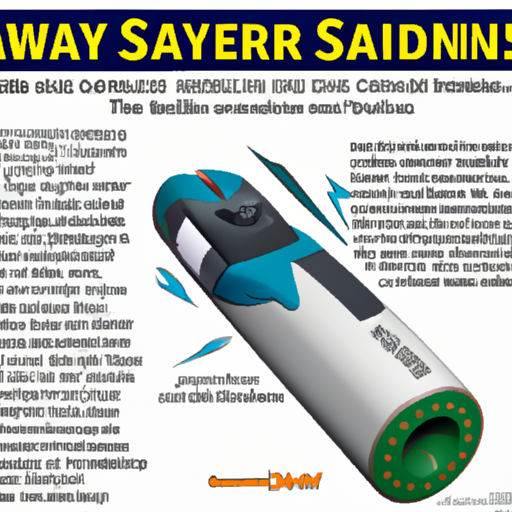Have you ever used a battery-powered sander for your DIY projects? We know how convenient they can be, allowing us to easily tackle sanding tasks without having to worry about cords or finding a power source. But, just like any power tool, it’s important to take certain safety precautions to ensure that we can use the sander without any accidents or injuries. In this article, we will discuss the content safety precautions that we should keep in mind when using a battery-powered sander, so keep reading to learn more!
First and foremost, it is crucial to wear protective gear when using a battery-powered sander. We recommend wearing safety glasses to protect our eyes from any flying debris or dust particles. Additionally, using a dust mask or respirator will help prevent us from inhaling harmful dust or fumes that may be generated during sanding. It’s also a good idea to wear ear protection, such as earmuffs or earplugs, to minimize the noise produced by the sander.
Another important safety precaution is to ensure that the battery in our sander is fully charged before using it. A low battery may result in decreased performance, which can lead to accidents or undesirable outcomes. It’s also important to familiarize ourselves with the sander’s user manual and follow the manufacturer’s instructions for proper handling and usage. This will help us understand the capabilities and limitations of the tool, and prevent any misuse or accidental damage.
Finally, it’s crucial to use the battery-powered sander with caution and mindfulness. Always maintain a firm grip on the tool, and avoid applying excessive pressure or force. Let the sander do the work for us, and avoid any sudden movements that may cause the sander to slip or cause uneven sanding. It’s also important to be aware of our surroundings and keep our fingers, hands, and other body parts a safe distance away from the sanding area.
In conclusion, when using a battery-powered sander, it’s important to prioritize our safety by wearing protective gear, ensuring a fully charged battery, and using the tool with caution. By following these content safety precautions, we can enjoy the convenience and efficiency of a battery-powered sander without compromising our well-being. To learn more about using power tools safely, keep an eye out for our upcoming articles. Happy sanding!

1. Understanding Battery-Powered Sanders
Battery-powered sanders have revolutionized the way we approach sanding projects. These handy tools offer convenience and ease of use, making sanding tasks faster and more efficient. However, it is important to understand the different types of battery-powered sanders and the advantages they offer.
Different Types of Battery-Powered Sanders
There are various types of battery-powered sanders available in the market, each designed for specific applications. The most common types include:
-
Orbital Sanders: These sanders feature a circular sanding pad that moves in an orbital motion. They are great for finish sanding and removing sharp edges.
-
Random Orbital Sanders: These sanders have a round sanding pad that moves in an elliptical motion while simultaneously spinning. They are versatile and can handle both rough and finish sanding tasks.
-
Detail Sanders: These sanders are perfect for getting into tight corners and intricate spaces. They are small and lightweight, making them ideal for small-scale projects.
Advantages of Using a Battery-Powered Sander
Using a battery-powered sander provides several advantages that make sanding tasks easier and more efficient. Some of the key benefits include:
-
Portability: Since battery-powered sanders operate on rechargeable batteries, they can be used anywhere without the need for a power source. This makes them highly portable and convenient for both indoor and outdoor projects.
-
Cordless Operation: The absence of a power cord eliminates the hassle of untangling wires and enables greater freedom of movement. This makes it easier to maneuver the sander around different angles and surfaces.
-
Less Noise and Vibration: Battery-powered sanders tend to produce less noise and vibration compared to their corded counterparts. This not only makes the sanding process more comfortable but also reduces fatigue during extended use.
2. Importance of Safety Precautions
While battery-powered sanders offer many advantages, it is crucial to prioritize safety when using these tools. Failure to follow proper safety precautions can result in accidents and injuries. Understanding the potential hazards and implementing safety measures is essential for a safe sanding experience.
Potential Hazards of Using a Battery-Powered Sander
Using a battery-powered sander without taking proper precautions can expose you to various hazards, including:
-
Hand Injuries: The fast-moving sanding pad can cause injuries if it comes into contact with your hands or fingers.
-
Eye Injuries: Flying debris and particles can cause severe eye injuries if proper eye protection is not worn.
-
Respiratory Issues: Sanding generates fine dust particles that can be harmful if inhaled. Prolonged exposure to dust without proper respiratory protection can lead to respiratory issues.
Why Safety Precautions are Necessary
Implementing safety precautions when operating a battery-powered sander is necessary to minimize the risk of accidents and injuries. Taking the following precautions ensures a safe working environment:
-
Protecting Yourself: Wearing appropriate personal protective equipment (PPE) such as safety goggles, respiratory masks, and gloves helps protect your eyes, respiratory system, and hands from potential hazards.
-
Preventing Accidents: Clearing the work area of clutter and obstructions minimizes the risk of tripping or falling during sanding. Adequate lighting is also necessary to ensure that you can see your work area clearly and avoid accidents.
-
Controlling Dust: Proper dust control measures, including the use of dust extraction systems, help prevent the inhalation of harmful dust particles. Regularly cleaning up after sanding also helps maintain a clean and safe working environment.
3. Personal Protective Equipment (PPE)
When using a battery-powered sander, wearing appropriate personal protective equipment (PPE) is essential to protect yourself from potential hazards. There are specific PPE items that should be used for different parts of the body.
Selecting and Using Eye Protection
Protecting your eyes is of utmost importance when using a battery-powered sander. The high-speed sanding action can produce flying debris and particles that can cause serious eye injuries. Therefore, it is vital to wear safety goggles that provide full eye coverage and have impact-resistant lenses. These goggles should fit snugly and comfortably to ensure maximum protection. Regularly inspect the goggles for any damages or scratches that may impair visibility, and replace them if needed.
Choosing the Right Respiratory Protection
Another crucial aspect of personal safety when using a battery-powered sander is respiratory protection. Sanding generates fine dust particles that, if inhaled, can cause respiratory issues and long-term health problems. Wearing a respiratory mask or respirator with proper filtration capabilities is essential to prevent the inhalation of these particles. Select a mask that is specifically designed for sanding purposes and conforms to the relevant safety standards. Make sure to replace the filter regularly to maintain its effectiveness.
Wearing Protective Gloves and Clothing
Protective gloves and clothing provide an extra layer of protection against potential injuries and hazards. When selecting gloves, choose ones that fit snugly and allow for a firm grip on the sander. Look for gloves that provide excellent dexterity and are made from materials such as leather or synthetic materials that offer good resistance to abrasion. Additionally, wearing long-sleeved shirts and long pants helps protect your arms and legs from dust, debris, and accidental contact with the sanding pad.
4. Work Area Safety
Ensuring a safe work area is crucial when using a battery-powered sander to prevent accidents and injuries. Taking the necessary precautions while setting up the work area can significantly contribute to a safer sanding experience.
Preparing the Work Area
Start by clearing the work area of any unnecessary clutter or obstructions. Remove any items that could get in the way or pose a tripping hazard. Keep the area well-organized, making it easier to move around and operate the sander safely. Additionally, ensure that the work surface is stable and secure to prevent it from shifting or wobbling during sanding.
Ensuring Adequate Lighting
Proper lighting is essential for a safe and accurate sanding experience. Insufficient lighting can make it difficult to see the work area clearly, increasing the risk of accidents. Ensure that the work area is well-lit, either by natural light or artificial lighting sources. Consider using additional spotlights or task lights to illuminate specific areas that require detailed sanding.
Clearing Clutter and Obstructions
Remove any objects, wires, or cords that may obstruct your movement or become entangled with the sander. Keep the power cord or battery pack away from the work area to prevent accidental tripping or interference with sanding operations. Taking the time to clear the work area of clutter and obstructions reduces the risk of accidents and creates a safe environment for sanding.

5. Battery Handling and Charging
Proper handling and charging of the battery for your battery-powered sander is essential for both safety and performance. Battery mishandling or faulty charging practices can lead to accidents, reduced battery life, or even damage to the sander.
Proper Battery Handling
Always handle the battery and battery pack with clean, dry hands. Avoid exposing the battery to extreme temperatures or moisture, as this can cause damage or reduce its performance. When removing or inserting the battery, ensure that the power switch is turned off to prevent accidental start-up. Additionally, store the battery in a cool, dry place away from direct sunlight to maintain its longevity.
Charging Safety Tips
Follow the manufacturer’s guidelines for charging the battery. Use only the provided charger or a charger specifically designed for your battery model. Never attempt to modify or repair the charger yourself. Before charging, inspect the battery for any visible damage, leaks, or signs of overheating. If you notice any abnormalities, do not charge the battery and contact the manufacturer for further instructions. It is also important to keep the charging area well-ventilated and avoid charging the battery near flammable materials.
Storage and Transportation Precautions
When storing or transporting the battery-powered sander, remove the battery from the tool for safety reasons. This reduces the risk of accidental activation or damage during transit. Store the battery in a secure, well-ventilated location away from children and pets. Use the original packaging or a dedicated battery case to protect the battery from impact and exposure to extreme temperatures.
6. Sander Operation Safety
Operating a battery-powered sander safely involves understanding the tool’s features, inspecting it before use, and using the sander correctly.
Reading and Understanding the User Manual
Before using a battery-powered sander, it is essential to read and understand the manufacturer’s user manual. The user manual provides critical information on the tool’s operation, safety guidelines, and maintenance procedures. Familiarize yourself with the specific features, controls, and safety precautions described in the manual to ensure proper and safe use of the sander.
Inspecting the Sander before Use
Before starting any sanding task, inspect the sander for any visible damage or defects. Check the power cord, battery pack, sanding pad, and any other components for signs of wear or malfunction. If you notice any issues, refrain from using the sander and have it inspected or repaired by a qualified technician. Regularly clean the sanding pad and remove any debris that may hinder its performance.
Using the Sander Correctly
When operating the battery-powered sander, firmly grip the handle to maintain control and stability. Apply even pressure and let the sander do the work; avoid excessive force or pushing down too hard, as this can affect the sanding quality and increase the risk of accidents. Move the sander in a smooth and consistent motion, following the grain of the material being sanded. Avoid abrupt stops or changes in direction that may cause the sander to kickback.
7. Dust Control Measures
Dust control is crucial when using a battery-powered sander to protect your health and maintain a clean working environment. Implementing effective dust control measures helps prevent the inhalation of harmful dust particles and minimizes the risk of dust-related health issues.
Importance of Dust Control
Sanding generates a significant amount of fine dust particles that can pose serious health risks if inhaled. Prolonged exposure to dust particles can lead to respiratory issues, allergies, and even lung diseases. Additionally, excessive dust can accumulate on the work surface, reducing visibility and affecting the sanding quality. Therefore, implementing dust control measures is essential for both personal safety and achieving optimal sanding results.
Using Dust Extraction Systems
Dust extraction systems or vacuum attachments are effective tools for capturing and containing dust generated during sanding. These systems are designed to connect to the sander and suck in the dust as it is produced. They typically employ filters and dust collection bags to trap the dust particles, preventing them from being released into the air. Regularly clean or replace the filters and empty the dust collection bags to maintain their efficiency.
Cleaning Up After Sanding
After completing a sanding task, it is crucial to thoroughly clean up the work area. Use a vacuum cleaner or a broom with a dustpan to remove any residual dust and debris. Wipe down surfaces with a damp cloth to remove any fine dust particles that may have settled. Properly dispose of the collected dust and debris according to local regulations. Regularly cleaning the work area not only ensures a safe working environment but also helps prolong the lifespan of your battery-powered sander.
8. Emergency Preparedness
Being prepared for emergencies while using a battery-powered sander is an essential aspect of ensuring personal safety. Familiarize yourself with emergency stops, have access to first aid and fire extinguishers, and know how to handle accidents and injuries.
Knowing the Location of Emergency Stops
Before starting any sanding task, locate and familiarize yourself with the emergency stops or shut-off buttons on the sander. In the event of an emergency or if the sander malfunctions, knowing how to immediately stop the tool can prevent further accidents or injuries.
First Aid and Fire Extinguishers
Have a well-stocked first aid kit easily accessible in your work area. The kit should contain items such as bandages, antiseptic solution, and adhesive tape for treating minor injuries. Additionally, ensure that a fire extinguisher suitable for extinguishing electrical fires is within reach. Familiarize yourself with the proper use of the fire extinguisher and regularly inspect it to ensure it is in good working condition.
Handling Accidents and Injuries
In the event of an accident or injury, it is important to respond quickly and appropriately. If the injury is severe or life-threatening, seek medical attention immediately. For minor injuries, administer basic first aid treatment according to the instructions in your first aid kit. Document any accidents or injuries that occur and report them to the necessary authorities or your supervisor. Learning basic first aid procedures can make a significant difference in the outcome of an emergency situation.
9. Maintenance and Inspection
Regular cleaning, maintenance, and inspection of your battery-powered sander are necessary to ensure its optimum performance and safety. By implementing proper maintenance routines, you can identify and address any issues before they escalate.
Regular Cleaning and Maintenance
After each use, clean the sander to remove dust and debris that may have accumulated. Use a soft brush or compressed air to clean hard-to-reach areas. Regularly inspect and clean the sanding pad, ensuring it is free from any residual material that may affect its performance. Lubricate any moving parts according to the manufacturer’s recommendations to maintain smooth operation.
Inspecting for Damage and Malfunction
Regularly inspect the sander for any signs of damage, wear, or malfunction. Check the power cord, battery pack, and other components for fraying, cracks, or loose connections. Examine the sanding pad for any signs of deterioration or uneven wear. If you notice any abnormalities, immediately stop using the sander and have it inspected or repaired by a qualified technician.
Replacing Parts and Batteries
Over time, certain parts of the sander may wear out or require replacement. Follow the manufacturer’s recommendations for replacing worn-out parts, such as sanding pads or brushes. When replacing the battery, ensure that you use a compatible battery pack that meets the manufacturer’s specifications. Dispose of old or damaged batteries according to local regulations and avoid throwing them in regular trash bins.
10. Conclusion
Sanding projects can be completed quickly and efficiently with the help of battery-powered sanders. However, it is crucial to prioritize safety by implementing the necessary precautions. By understanding the potential hazards, wearing the appropriate personal protective equipment (PPE), preparing the work area, handling and charging batteries correctly, operating the sander safely, controlling dust, being prepared for emergencies, and practicing regular maintenance and inspection, we can ensure a safe sanding experience.
Remember, safety should always be our top priority when using a battery-powered sander. By following the outlined safety precautions, we can enjoy the convenience and efficiency of these tools while minimizing the risk of accidents and injuries. It is our responsibility to use battery-powered sanders responsibly and encourage others to do the same, ensuring a safe and productive work environment for everyone involved.
